©
2004 Jeff Matthews & napoli.com
Krupp, Alfred; Capri (2)
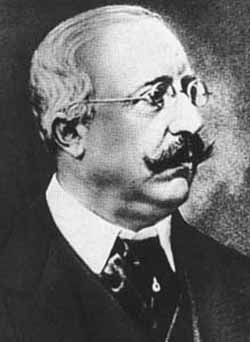 Friedrich
"Fritz" Alfred Krupp (1854-1902)—the "Cannon King" and bearer
of a name tenaciously associated with German industry and militarism—was
taken with Capri and is, in a sense, still present on the island in
the trail that bears his name, the Via Krupp, a spectacular footpath
leading down the sheer south side of the island to the sea. Friedrich
"Fritz" Alfred Krupp (1854-1902)—the "Cannon King" and bearer
of a name tenaciously associated with German industry and militarism—was
taken with Capri and is, in a sense, still present on the island in
the trail that bears his name, the Via Krupp, a spectacular footpath
leading down the sheer south side of the island to the sea.
Krupp made
his first visit to the island in 1898, on his doctor's orders. This
otherwise practical man became the incurable romantic on the island,
palling around with local fishermen and sitting in small taverns listening
to Neapolitan songs. He also indulged his amateur passion for marine
biology by assisting the great German naturalist (and founder of the
Naples Aquarium), Anton Dohrn, who was doing research in the Bay of
Naples.
Other than
marine biology, 'Fritz' devoted much of his time on Capri to a grotto
that had been the abode of a 16th century religious recluse, one Fra
Felice. Krupp turned the cave into a "pleasure palace," replete with
golden keys for the gates, keys that he gave to his close friends on
the island, young fishermen, waiters, etc. He referred to his
grotto as the "holy place of a secret fraternity," thus doing
little to allay rumours about the nature of the pleasure being pursued
by himself and his young male friends. Krupp built a path to the cave
and then offered to expand it to lead from the certosa
(a 15th-century monastery) down to the Marina Piccola, the small harbor. The project was accepted by the island authorities,
and it was this path that became the Via Krupp. It was finished by the
spring of 1902. A few months later, apparently driven to it by the scandals
surrounding his alleged perversions on Capri, Krupp, ruler of the giant
German industrial dynasty, this richest man in Germany, died by his
own hand.
(Fritz
left the world's most impressive munitions factory to Gustav von Bohlen-Halbach,
his daughter Bertha's husband. A few years later, Gustav built
the largest artillery piece in history to lob shells into Paris
from 50 miles away in WWI. That weapon was nicknamed "Big Bertha,"
which tells me more than I really want to know about life in the Bohlen-Halbach
household!)
As for
the Via Krupp, it is currently closed. It is not a recent problem.
It was a difficult path to build, and there have always been problems
with falling rock. Nevertheless, for over sixty years, it was
kept clear by the practical expedient of a man on the end of a
pulley going down the side of the cliff and knocking down dangerous
bits of the cliff face before they fell. Authorities, however,
decided that it was no longer worth the expense to keep the trail free,
and they closed it in 1978.
It is now
awaiting a decision on just how to make it safe. There have been a
number of plans. One called for covering the rock-face with the
same type of metal netting that one sees in similar terrain all over
the world (and on Capri, itself, on the cliff-face as you wind up the
road to Anacapri). Another involved the application of that 'natural-looking'
concrete spray (the kind that generally draws comments like, "Say, that
almost looks real, doesn't it?"). Finally, some wanted to build
a sheltered passageway, a tunnel, along at least parts of the trail,
to protect hikers from falling rock.
It is really
a two-fold problem. One involves the safety of the trail itself. That
is hard, but not that hard. They did it for decades. Two is somewhat
more intricate. It is the perception that the Via Krupp is somewhat
of a metaphor of not only the entire island, but of similar places
that depend on a tourist economy throughout the world. Paul Fussel's
term 'pseudo-place' comes to mind, a description of those formerly
small towns and villages that today have the sole function of luring
in tourists and selling them things. Many are worried that Capri has
become—or is becoming—just such a 'pseudo-place',
a process that will only be accelerated by applying concrete or
building sheltered passageways along the island's most famous path.
It's a
hard compromise to find. Certainly, one should not fall for the myth
that before the Isle of Capri was invaded by hordes of tourists, it
was some idyllic gem set in the sea, a paradise for inhabitants
and visitors alike. Our impression of Capri as the "Isle of Pleasure"
has been formed largely by foreigners who had enough money to enjoy
the island on their own terms, and who, it might be noted, were greatly
resented by the local population, farmers and fishermen whose harsh
lot improved only with the beginning of tourism on Capri at the turn
of the century. On the other hand, the Via Krupp has always been a strange
combination of nature and the hand of man, somewhat like Japanese Bonsai.
Maybe a bit a falling rock isn't such a bad idea.
Aquarium,
villa comunale (2)
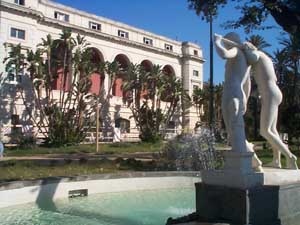 Elia
Mannetta, the engineer from Baltimore who built the new aquarium in
Genoa, will be in Naples in a week or so to help decide if the city
of Naples needs a new aquarium and, if so, where to put it. There are
three candidates: (1) in San Giovanni a Teduccio, a suburb of Naples
just to the east along the coast; (2) Bagnoli, where a new aquarium
would fit in nicely with the pedagogical ambitions of the Science City
exposition and fair grounds as well as with a general rejuvenation of
the area after decades of decay; (3) in the Villa Comunale, where a
new aquarium would take the place of the older one, the Anton Dohrn
Aquarium, in place since the 1870s. Choice number 2, Bagnoli, is probably
the strongest candidate. Elia
Mannetta, the engineer from Baltimore who built the new aquarium in
Genoa, will be in Naples in a week or so to help decide if the city
of Naples needs a new aquarium and, if so, where to put it. There are
three candidates: (1) in San Giovanni a Teduccio, a suburb of Naples
just to the east along the coast; (2) Bagnoli, where a new aquarium
would fit in nicely with the pedagogical ambitions of the Science City
exposition and fair grounds as well as with a general rejuvenation of
the area after decades of decay; (3) in the Villa Comunale, where a
new aquarium would take the place of the older one, the Anton Dohrn
Aquarium, in place since the 1870s. Choice number 2, Bagnoli, is probably
the strongest candidate.
Very few
Neapolitans would like to see the Villa Comunale dug up and closed again
(as it was a few years ago for restoration) or see the current aquarium
demolished. It fits in with the general old-fashioned atmosphere of
the park—classical statues, fountains, gazebo/bandstands, etc.—though
that, too, has changed a bit since the recent overhaul. Not only did
they chop down a lot of trees ("Diseased," some said…"My brother–in–law
needs firewood," said others) but they replaced a number of 19th–century
metal scrolls and curlicues along the fence with more modern bulletoid
metalwork that has already midwifed an entire repertoire of suppository
jokes.
(For a
sepate entry on the Villa Comunale.)
Mercato,
Piazza (2); Carmine (church and square)
I am looking
for a word—"psychotactility"?— to describe that sensation
you get when you lay your hands on something ancient—part of a
Greek wall, say, in Naples, and close your eyes and suddenly feel that
you are in touch with the ancient Greeks. ("Ulysses? Is that you? Can
you hear me?" It's ok to talk during these episodes. The people near
you will just think you're using a hands–free cell–phone.)
That sensation doesn't happen to me very often. Well, all right—it
has never happened; I just thought it would be nice to have a word for
it.
One place
it really doesn't happen is in the middle of a squalid parking
lot that used to be one of the most important sites in the city. I tried
again today, and all I "felt" were the cars. ("Mr. Ford? Mr. Daimler?
Are you there? Curse you!") I am referring to Piazza Mercato—"Market
Square," the setting for a number of episodes of extreme interest in
the history of Medieval Europe.
The square
is at the easternmost point of the old medieval wall along the
coast (see this entry) where the Carmine
Castle used to stand. The historic old church, Santa Maria del Carmine
(also called Carmine Maggiore) is just off the square. It is still in
use and the75–meter belfry is still visible from a distance even
amidst newer and taller buildings.
For such
a noteworthy church, its pedigree is obscure. A document from 1589,
the Cronistoria del Convento, by one Padre Moscarella, says that
the church was founded in the 12th century by Carmelite monks driven
from the Holy Land during the Crusades, presumably arriving in the Bay
of Naples aboard Amalfitan ships. Other sources place the original refugees
from Mount Carmel as early as the eighth century. Whatever the case,
the fact remains that by 1268, the date of the execution in Piazza Mercato
of Conradin, the last Hohenstaufen pretender to the throne of the Kingdom
of Naples, at the hands of Charles I of Anjou, the church and adjacent
monastery were well established. The square, itself, had become the
largest market place in the city, having replaced in importance the
ancient market in the heart of the old city, itself.
With the
execution of Conradin, the square also became the place for official
executions and would remain so for many centuries. It was the site of
the grisly Bourbon executions of Republican
revolutionaries in 1799. It was for centuries a general gathering
place, watering hole and focal point for celebration as well as rebellion.
In 1647 the square was where trouble broke out between rebels and royalist
troops during Masaniello's Revolt and
a last-stand rallying point for Bourbon forces resisting Garibaldi's
move on Naples in 1860.
All of
that history was ploughed under during the great Risanamento—Urban Renewal—of Naples
around 1900. The new port road was put in, the old castle demolished,
part of the monastery, itself, torn down, etc. Whatever else the merits
of the Risanamento were, it shifted the center of the city well away
from the port and to the west. The new straight road through town, Corso
Umberto, divided the city in half. The port half—Piazza Mercato—decayed
terribly over the decades. It was also subjected to aerial bombardment
in WWII. The area is just now coming back to life—unfortunately
with the worst imaginable mishmash of architecture.
The Church
of the Carmine continues to thrive and serve the needs of the faithful
in the area. The old monastic premises adjacent to the church now serve
as a shelter for the needy and homeless. The church is home to two remarkable
religious relics: One, the painting of the "Brown Madonna," said to
have been brought by the original Carmelites; two, a figure of the Crucifixion
in which the crown of thorns is missing. Legend says that the crown
fell as Christ's head moved when the building was struck by a cannon
ball in 1439.
Yet, as
I said at the top of this entry, there is very little of all that still
hanging around in the air, if you will. The square is now a totally
anonymous and grimy parking lot.
Cars
(1)
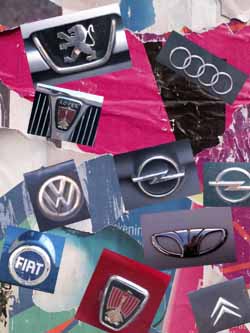 There
really is no place to park a car in Naples anymore. Double-parking is
so common that traffic cops look the other way. They have a difficult
time drawing a firm line in the sand on this issue since most of the
beaches, too, are strewn with illegally parked cars. You may get a ticket
if you triple-park and swing open the driver-side door into passing
traffic, thereby causing some poor kid on a motor–bike to slam
into you and go flying over the door. ("But he wasn't wearing a helmet,"
you can always argue. And he probably wasn't.) Sometimes cars are towed,
but it seems to be random. There isn't as much bad feeling over towed
cars as one might think because if you come out of your house and find
your car gone, you naturally think that it's been stolen. That's an
ineluctable force of nature in Naples. No sense getting riled up over
that. There
really is no place to park a car in Naples anymore. Double-parking is
so common that traffic cops look the other way. They have a difficult
time drawing a firm line in the sand on this issue since most of the
beaches, too, are strewn with illegally parked cars. You may get a ticket
if you triple-park and swing open the driver-side door into passing
traffic, thereby causing some poor kid on a motor–bike to slam
into you and go flying over the door. ("But he wasn't wearing a helmet,"
you can always argue. And he probably wasn't.) Sometimes cars are towed,
but it seems to be random. There isn't as much bad feeling over towed
cars as one might think because if you come out of your house and find
your car gone, you naturally think that it's been stolen. That's an
ineluctable force of nature in Naples. No sense getting riled up over
that.
A gentleman
put "a modest proposal" in the paper the other day. A decade ago, the
city cleared out Piazza Plebiscito, the large square in front
of the Royal Palace in Naples. It has been returned to its natural,
wide–open, pristine state—spacious, clean, and eminently
walk-aroundable. The gentleman points out that "wide open spaces" are
all right for the Wild West and Asian steppes but we are human beings,
not buffalo, and such an area is not natural in the least wide-open
space in western Europe, Naples.
Let the
cars return, he argued. Bring those thousands of vehicles back from
the parallel, quantum Naples that they are star–gated to every
morning and let them park here in the real Piazza Plebiscito
where they belong. Certainly, nothing could be worse than the presence
of various works of "art" that take up space in the square a lot of
the time, from castles made of Coca–Cola cans to mountains of
salt to this year's display
of 100 bronze skulls. Why not—in keeping with "Art for the
masses" ambitions of the city—put on a permanent display of parked
cars as "mobile installation art"? Then, instead of slurping coffee
and holding maps of the city upside-down, visitors to our fair city
can put in some quality tourist time by admiring the kaleidoscopically
changing colors—Matisse, eat your heart out!—of the
square as cars putt about looking for spaces, or by deconstructing the
semiotics of the Hittite tridents, runes, alchemical emoticons and gypsy
logoglyphs that serve as hood ornaments.
Names
of kings
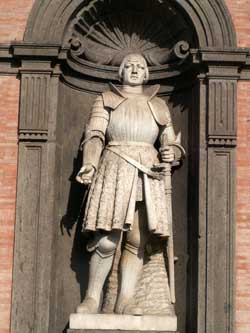 Astute
student of history that I am, I have figured out why monarchies have
not been doing too well, lately. It has nothing to do with sweeping
historical processes such as the Enlightenment or Hegelian Dialectics
or the guillotine. Quite simply, kings don't have really good nick-names
anymore—or 'bynames,' as they are properly termed. Astute
student of history that I am, I have figured out why monarchies have
not been doing too well, lately. It has nothing to do with sweeping
historical processes such as the Enlightenment or Hegelian Dialectics
or the guillotine. Quite simply, kings don't have really good nick-names
anymore—or 'bynames,' as they are properly termed.
In the
history of Naples, there is only monarch with a fine, regal by-name:
Alfonso the Magnanimous (1396-1458, photo), the one who wrested the
Kingdom of Naples from the Angevins in 1442. Other than that, Neapolitan
monarchs have been stuck with trifling nicknames. Ferdinand IV (later
Ferdinand I) (1751-1825) had two: Re Nasone and Re Lazzarone.
The first one means King Big Nose (Naso+ the augmentative suffix
–one). The second requires some explanation: Lazarus is
the patron saint of lepers, and, by extension, all miserable outcasts.
Neapolitan members of the "great unwashed peasant masses" were thus
called "lazzaroni". In an age of rigid social stratification,
it was not a derogatory term—it was a description. Ferdinand was
a notorious simpleton and vulgarian, and he enjoyed hanging around with
the common folk down at the port. He was popular, and both names were
terms of endearment bestowed on him by the Neapolitan masses. He was,
thus, the Great Unwashed Peasant King; it was an expression of solidarity
with the people, and he took no offense at that term or the one about
his nose.
His grandson,
Ferdinand II (1810-1859), was nicknamed "Bomba"—bomb—as
a result of his bombardment of Messina during the political unrest
in 1848. And his son, the last King of Naples, Francis II was known
as "Bombalino"—Little Bomb. All of these example were nicknames,
not by–names—not Someone THE Something.
There hasn't
been Anyone the Great in a long, long time: Alexander, Alfred, Peter,
Frederick, Katherine and, of course, Charles the Great (commonly known
by the Frenchified version, "Charlemagne"). Now that was a name fit
for royalty! I bet you could call them that, too. O, Great One!
Your Greatness! O, Generous Dispenser of Greatosity! or maybe,
simply, Oh, Great! They couldn't possibly have minded.
Or Leo
the Wise and Charles the Noble. Those were names! "Yes, Your Wiseness";
"You Bet, O Noble One!" —and in the case of our Neapolitan, Alfonso,
"Count on it, Your Magnanimosity!" Those old rulers knew that
21st–century history students would have attention spans roughly
equal to the reign of Harvey the Short Lived, and would not be remember
complex items like Vth or IIIrd or XXIst, so they tacked on little memory
boosters.
Charlemagne's
grandfather wasn't taking any chances on not being remembered. He was
called Charles Martel —Charles The Hammer! Imagine that! The Hammer!
When they were choosing Dark Age kings in the eighth century, they went
right around the group:
"OK, which
one of you guys wants to be king? Robert IV?…Got any experience,
Bob? Junior League jousting coach, huh? Let's see …"
Then suddenly
from the gloom in the back of the tent comes that rich Dark Age baritone
of command:
"They call
me 'The Hammer'!"
Forget
'Will you open the envelope, please.' End of discussion, right there.
I'm not so sure you could actually call him that, though. I mean, do
you really want to pal around with someone called The Hammer? What happens
if this guy has some Thor-like flashback and starts flailing about in
a fit of Royal Peevishness? You get one tankard too many of the Good
Grape into someone called The Hammer and you can put some serious dents
in Ye Olde Royal Happie Hour, and that's the sooth. His son was Pepin
the Short! O, Great One! —definitely. Your Wisehood!—yes.
And maybe even, under specially contrived circumstances, O, Most Hammering
One! But, Hey, Shorty!—I don't know.
A bit on
either side of the year 1000 we have Charles the Bald, Charles the Fat,
Charles the Simple and Charles the Pious. I recall that two of those
terms refer to the same person; thus, one of them was either The Bald
& Fat, The Fat & Pious, The Pious & Simple, The …let's
see… carry the 2 … well, you can work out the rest.
And what
can you say about Louis the Child? If I am intercalating all the leap
years in my Dark Age calendar correctly, this guy was an adult whom
they called "The Child". Go figure. "Is'm widdle queenie's gweat big
kingie-boo? Yes'm is!" On that note, maybe we'd have to ask Mrs.
Ethelred the Unready about the real story behind her husband's name.
Pietrarsa
(railway museum); Trains (2)
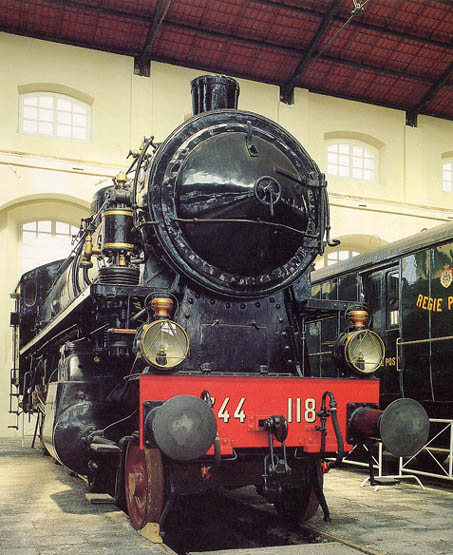 Unfortunately, one of the
most interesting museums in Naples is still closed for extensive repairs.The
Railway Museum of Pietrarsa is one of the most complete in the world.
It is located on the premises of the former metal foundry of the Kingdom
of Naples, a facility that produced most of the boilers for locomotives
and steam-driven ships in the kingdom in the first half of the 19th century. Unfortunately, one of the
most interesting museums in Naples is still closed for extensive repairs.The
Railway Museum of Pietrarsa is one of the most complete in the world.
It is located on the premises of the former metal foundry of the Kingdom
of Naples, a facility that produced most of the boilers for locomotives
and steam-driven ships in the kingdom in the first half of the 19th century.
The museum
contains original engines as well as scale models incorporated into
a display of the history of trains in Italy. The displays include the
Bayard, the first locomotive in Italy. It started its run from Naples
to Portici on October 3, 1838. With the unification of Italy, the construction
of steam boilers was taken over by industry in the North and Pietrarsa
was relegated to the role of a repair facility. It served in that capacity
until the 1970s when the facility was rendered obsolete by advances
in diesel and electrical technology. It opened as a museum in 1989.
Conservatory,
Music (1); San Pietro a Maiella
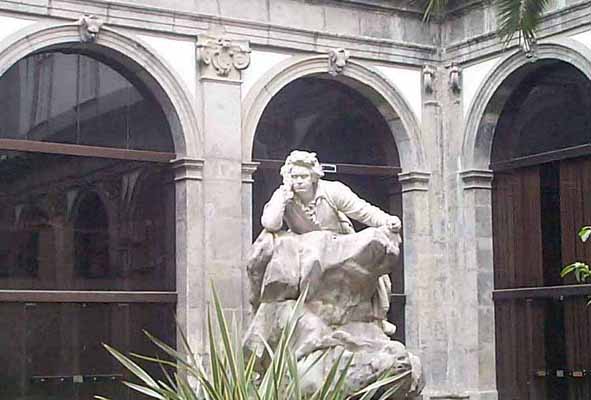 I got a note from a woman in France the other day asking
me if she could use my snapshot of the statue of Beethoven located on
the premises of the Naples Music Conservatory. That gave me an excuse
to wander down to that part of the city and have another look at the
place. The conservatory is right near Piazza
Bellini and a long street, via San Sebastiano, known simply
as the "music street" because every shop on it sells musical instruments.
It's always a pleasure to walk by the conservatory and listen to the
sounds of students practicing. The statue of Beethoven, indeed, broods
prominently in the courtyard of the conservatory. I had the opportunity
to take another photograph for the young woman and to learn that the
statue is the work of the prominent Calabrian sculpture, Francesco
Jerace. I got a note from a woman in France the other day asking
me if she could use my snapshot of the statue of Beethoven located on
the premises of the Naples Music Conservatory. That gave me an excuse
to wander down to that part of the city and have another look at the
place. The conservatory is right near Piazza
Bellini and a long street, via San Sebastiano, known simply
as the "music street" because every shop on it sells musical instruments.
It's always a pleasure to walk by the conservatory and listen to the
sounds of students practicing. The statue of Beethoven, indeed, broods
prominently in the courtyard of the conservatory. I had the opportunity
to take another photograph for the young woman and to learn that the
statue is the work of the prominent Calabrian sculpture, Francesco
Jerace.
Popular
Neapolitan etymology suggests that Naples is where the term conservatorio
was first used to mean 'music school'. Originally, however, a
conservatorio was where they conserved young, unmarried women
with children as well as orphans; thus, a 'conservatory' was a shelter
or orphanage. There were so many orphans being trained in music in these
church-run orphanages that the transfer of meaning came about rather
naturally over time.
These music
conservatories in Naples go back to the mid-1500s when the Spanish rulers
set up schools to train young singers on the premises of four monasteries
in the city: Santa Maria di Lorento, Pietà dei Turchini, Sant'Onofrio
a Capuana, and I Poveri di Gesù Cristo. They enjoyed a considerable
reputation as training grounds not only for young children to
be trained in church music, but, eventually, as a 'feeder system' into
the world of commercial music once that opened up in the early
1600s.
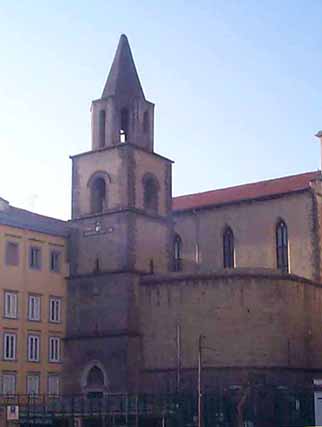 In 1806, with Napoleon Bonaparte's brother,
Joseph, installed as the king of Naples in what would be a
decade of French rule of the kingdom, monastic life in the kingdom
was drastically reorganized and the four monastery music schools were
consolidated into a single building, the Church of San Sebastiano.
In 1826 that consolidated conservatory was moved to the present
site, the ex-monastery, San Pietro a Maiella). The conservatory (still
bearing the inscription 'Royal Academy of Music' over the entrance)
is still an important music school in Italy. It houses an impressive
library of manuscripts pertaining to the lives and musical production
of composers who lived and worked
in Naples, among whom are A. Scarlatti, Pergolesi,
Cimarosa, Rossini,
Bellini, and Donizetti.
The historical museum has a display of rare antique musical instruments. In 1806, with Napoleon Bonaparte's brother,
Joseph, installed as the king of Naples in what would be a
decade of French rule of the kingdom, monastic life in the kingdom
was drastically reorganized and the four monastery music schools were
consolidated into a single building, the Church of San Sebastiano.
In 1826 that consolidated conservatory was moved to the present
site, the ex-monastery, San Pietro a Maiella). The conservatory (still
bearing the inscription 'Royal Academy of Music' over the entrance)
is still an important music school in Italy. It houses an impressive
library of manuscripts pertaining to the lives and musical production
of composers who lived and worked
in Naples, among whom are A. Scarlatti, Pergolesi,
Cimarosa, Rossini,
Bellini, and Donizetti.
The historical museum has a display of rare antique musical instruments.
The conservatory
and adjacent church (photo, above) are both part of the old San Pietro
a Maiella monastery complex, built at the end of the 13th century and
dedicated to the monk Pietro da Morone, who became Pope Celestine V
in 1294. Celestine subsequently became the only Pope to abdicate, an
event that also took place in Naples, in the Maschio Angioino, the Angevin Fortress. At least
in Dante's version of the afterlife, Celestine resides in Hell. The
Divine Comedy places him just past the gates of Hell among the
Opportunists --(in John Ciardi's translation)-- "...the nearly soulless
whose lives concluded neither blame nor praise...[and in reference
to Celestine]...I recognized the shadow of that soul who, in his
cowardice, made the Grand Denial...". (To play the Pope's
advocate, I remind you that Dante was really upset at the fact
the Celestine, by quitting, left the door open to the subsequent Pope,
Boniface VIII, corrupt and, in Dante's view, responsible for much of
the evils that befell Dante's city of Florence.)
| This
interesting mosaic is found as part of the floor tiling within the
church. |
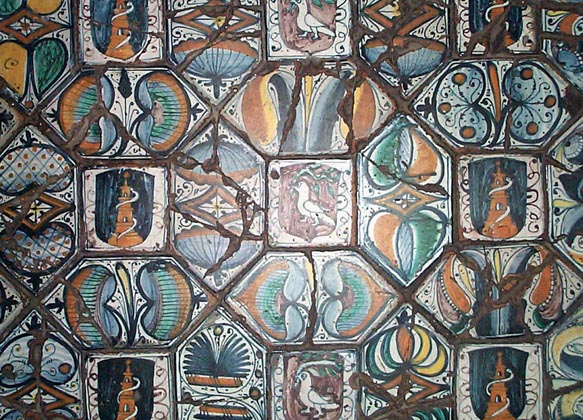 The
building is a square Gothic-style church; after a fire in 1407 it was
restored and enlarged by the addition of two chapels and the relocation
of the facade. The number of interesting art works within include a
chapel by an anonymous artisan that tell the story of Saint Martin,
and the numerous frescoes above the choir. The marble altar is
from 1645 and is by Cosimo Fanzago. The church was redone in Baroque
style, as evidenced by the paintings of Mattia Preti inserted into the
ceiling of the central nave. They depict the Story of the life of San
Celestino and Santa Caterina of Alexandria and were done in 1657-59.
The church is on a street of the same name near Port’Alba, within
the bounds of the old Greek city. The
building is a square Gothic-style church; after a fire in 1407 it was
restored and enlarged by the addition of two chapels and the relocation
of the facade. The number of interesting art works within include a
chapel by an anonymous artisan that tell the story of Saint Martin,
and the numerous frescoes above the choir. The marble altar is
from 1645 and is by Cosimo Fanzago. The church was redone in Baroque
style, as evidenced by the paintings of Mattia Preti inserted into the
ceiling of the central nave. They depict the Story of the life of San
Celestino and Santa Caterina of Alexandria and were done in 1657-59.
The church is on a street of the same name near Port’Alba, within
the bounds of the old Greek city.
The life
of the conservatory has always been bound up with that of another great
musical establishment in the city of Naples, San Carlo Theater. (Click here to read about San Carlo.)
Horse's
head
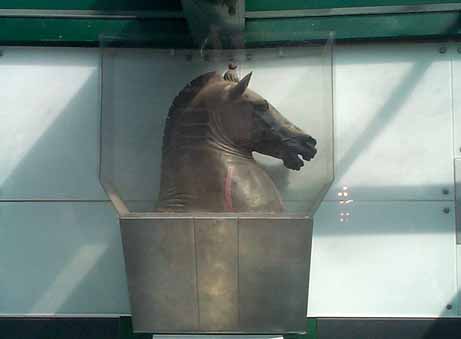 I
am always amazed to find something original in better condition than
the copy. I thought that was why they made copies—because the
originals were in such terrible danger of deteriorating. That is why
I set out to find the building in Naples called, popularly, ‘the
house of the horse’s head’. I
am always amazed to find something original in better condition than
the copy. I thought that was why they made copies—because the
originals were in such terrible danger of deteriorating. That is why
I set out to find the building in Naples called, popularly, ‘the
house of the horse’s head’.
Technically,
the name is Palazzo Santangelo (also known as Palazzo Diomede
Carafa) named for the representative of the Aragonese court who
erected this building in the middle of the 15th century. It incorporates
part of an earlier structure from the 1200s. It is one of the most interesting
Renaissance buildings in Naples, containing elements of Florentine and
Catalan architecture. The rectangular stone facade, marble portals and
wooden door are all original. Worn by time, but still visible, are twelve
niches depicting members of the Carafa lineage. The ‘Santangelo’
name of the building goes back to the person who bought the building
in 1813 and restored it, as well as making it a repository for works
of fine art, many of which, unfortunately, have gone missing over
the years. It is on via San Biagio dei Librai, also known as "Spaccanapoli".
It is the bottommost of the three parallel east-west streets that make
up the historic center of Naples, those streets that are laid over the
old Greek and Roman roads. The building is a block east of the large
square named Piazza San Domenico Maggiore. (See #22 on the map
of the historic center.)
I had heard
that there was a copy in the courtyard of a bronze horse’s head,
a gift to Carafa from Lorenzo the Magnificent. Much popular superstition
has formed around the statue over the years: for example, merely bringing
sick animals into the presence of the statue was said to work miraculous
cures! Naturally, the original statue would be lost, destroyed,
ravaged by time or otherwise not at my disposal, so I had to find the
copy.
This
"Hercules," a copy of the famous original in the
National Museum next door, is in the same train station.
 In my
heart of hearts, I think I was hoping to find peasants bringing their
sick goats and sheep to be healed. Alas, the building was an absolute
mess. It was in the agonizing process of being restored. There was scaffolding
on every wall in the courtyard; bricks were strewn about; and everything
was covered with fine powder blown off the piles of plaster and cement.
General construction debris was everywhere. But the horse was there.
The head was mounted on the back wall of the courtyard at about eye-level,
but it was barely visible beneath a rickety framework of pipe-and-wood
scaffolding; there was an overturned wheelbarrow in a pile of stucco
nearby. The statue was covered in grime and had become totally non-descript. In my
heart of hearts, I think I was hoping to find peasants bringing their
sick goats and sheep to be healed. Alas, the building was an absolute
mess. It was in the agonizing process of being restored. There was scaffolding
on every wall in the courtyard; bricks were strewn about; and everything
was covered with fine powder blown off the piles of plaster and cement.
General construction debris was everywhere. But the horse was there.
The head was mounted on the back wall of the courtyard at about eye-level,
but it was barely visible beneath a rickety framework of pipe-and-wood
scaffolding; there was an overturned wheelbarrow in a pile of stucco
nearby. The statue was covered in grime and had become totally non-descript.
I expressed
my disappointment to a gentleman standing nearby. I wondered when all
the work would be done. Hard to say. Probably a long time. Why didn't
I go see the original? The original? Sure. Up at the National Archaeological
Museum. It's on display, you know. I didn't.
Indeed.
I found the real horse's head, but not exactly where the gentleman said
it would be. The city—ever onward in its campaign to bring art
to the people—has moved this original gift from Lorenzo the Magnificent
next door to the new Museum stop of the Metro line—a train
station. Thus, as you trot down the stairs to get your train, you look
up over the entrance and there it is, encased behind protective plastic.
It is truly splendid and I shall return. I have a goat that is not feeling
too well.
Donn'Anna,
Villa
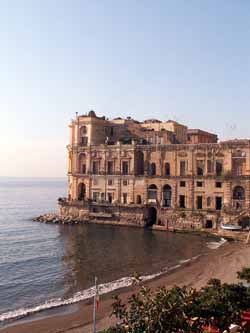 There
is much confusing, popular lore about this dreary building, located
on Via Posillipo as you start up that road from the Mergellina boat
harbor. It is called "Villa Donn'Anna" and if you ask residents of the
area, everyone is quick to tell you some variation of the theme that
this is where Queen Giovanna had sex orgies and murdered her lovers.
No one seems to be certain whether the Queen in question is Giovanna
(1326-1382), daughter of Charles, Duke of Calabria, or another Giovanna,
sister of King Ladislao. The first one had her husband murdered and
was accused of other foul deeds, as well. She looks like a good
candidate to be the evil queen, at least in the opinion of Italy's greatest
historian/philosopher of the 20th century, Benedetto Croce. There
is much confusing, popular lore about this dreary building, located
on Via Posillipo as you start up that road from the Mergellina boat
harbor. It is called "Villa Donn'Anna" and if you ask residents of the
area, everyone is quick to tell you some variation of the theme that
this is where Queen Giovanna had sex orgies and murdered her lovers.
No one seems to be certain whether the Queen in question is Giovanna
(1326-1382), daughter of Charles, Duke of Calabria, or another Giovanna,
sister of King Ladislao. The first one had her husband murdered and
was accused of other foul deeds, as well. She looks like a good
candidate to be the evil queen, at least in the opinion of Italy's greatest
historian/philosopher of the 20th century, Benedetto Croce.
To make
matters even more confusing, one Dragonetto Bonifacio is said to have
built the villa in the early 1400s, but there were apparently two persons
by that name at the same time in Naples!
The building
is on the site of the so-called "Rocks of the Siren" and, indeed, was
originally called "La Villa Sirena". It changed hands a number of tims
and finally was inherited in 1630 by the woman whose name it now bears,
Anna Stigilano, who then married the Spanish viceroy of Naples. She
had the building redone by the great architect, Cosimo Fanzago, in the
1640s and, since that time, the building has been called Villa Donn'Anna.
San
Bartolomeo
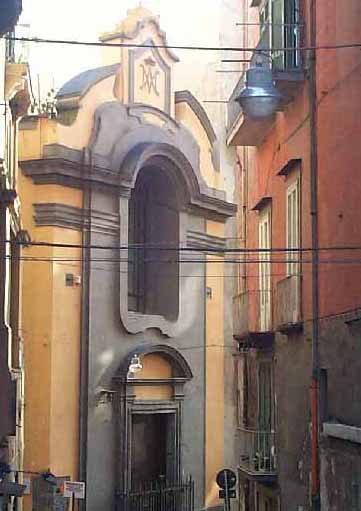 If you wander into the small maze of streets between
via Medina and via Depretis just west of Piazza Municipio, you will
find via San Bartolomeo. On this street is a tiny church —now
closed— called Santa Maria della Graziella. The church is on the
site of the original opera house of Naples and was opened as the San
Bartolomeo Theater in 1621. It, thus, got in on the beginnings
of opera, begun a few years earlier in Florence and turned into a full-blown
commercial venture in Venice in the early decades of the seventeenth
century. Early opera was even termed "musica Veneziana"—Venetian
music—in the Italy of the day, and it was not long before productions
of this delightful new music from the north were being performed in
Naples. If you wander into the small maze of streets between
via Medina and via Depretis just west of Piazza Municipio, you will
find via San Bartolomeo. On this street is a tiny church —now
closed— called Santa Maria della Graziella. The church is on the
site of the original opera house of Naples and was opened as the San
Bartolomeo Theater in 1621. It, thus, got in on the beginnings
of opera, begun a few years earlier in Florence and turned into a full-blown
commercial venture in Venice in the early decades of the seventeenth
century. Early opera was even termed "musica Veneziana"—Venetian
music—in the Italy of the day, and it was not long before productions
of this delightful new music from the north were being performed in
Naples.
San Bartolomeo
was destroyed by fire in 1681 but rebuilt at great expense almost immediately,
so important was its cultural contribution to the life of the city.
The theatre was the site where much of the great music of the Neapolitan
Baroque at the turn of the eighteenth century was performed for the
first time—music of Alessandro Scarlatti
and Pergolesi, for example. By the early
decades of the eighteenth century, however, the theater had decayed
so badly that the new monarch from Spain, Charles
III, decided that a new one should be built. When San Carlo was opened in 1737, the old San Bartolomeo
was closed and rebuit as a church. The architect who turned the theater
into a house of worship was Angelo Carasale, the same man who designed
the new theater of San Carlo.
Incoronata,
church
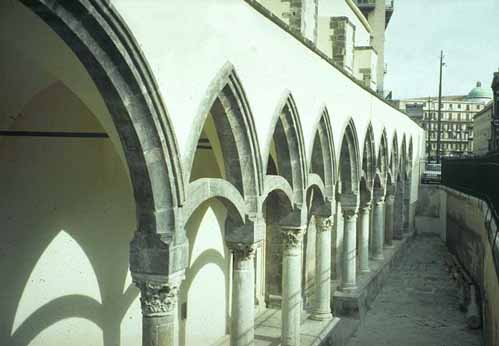 The Church of the Incoronata is on via Medina just a few
yards from Piazza Municipio.
The church gives you a good idea of how the city has changed over the
centuries. It is the oldest church in that part of Naples, stemming
from the 14th century, and is, in fact, the only building from that
century left standing so close to the main square. It is named in honor
of the coronation of Queen Giovanna I, which event took place in 1352.
There is some debate as to whether the church incorporated part of an
earlier building, a Hall of Justice. In any event, beginning with the
Angevins in that century, the street level adjacent to the church underwent
a gradual building up, especially in the early 1500s, when extensive
trench and moat building at nearby Maschio
Angioino produced vast amounts of land fill that was then used
to raise the street level. The modern road is well above the old street
level and entrance to the church. To enter the church today, youhave
to go down some steps. All other buildings on via Medina on both
sides of the street are at the higher street level. The Church of the Incoronata is on via Medina just a few
yards from Piazza Municipio.
The church gives you a good idea of how the city has changed over the
centuries. It is the oldest church in that part of Naples, stemming
from the 14th century, and is, in fact, the only building from that
century left standing so close to the main square. It is named in honor
of the coronation of Queen Giovanna I, which event took place in 1352.
There is some debate as to whether the church incorporated part of an
earlier building, a Hall of Justice. In any event, beginning with the
Angevins in that century, the street level adjacent to the church underwent
a gradual building up, especially in the early 1500s, when extensive
trench and moat building at nearby Maschio
Angioino produced vast amounts of land fill that was then used
to raise the street level. The modern road is well above the old street
level and entrance to the church. To enter the church today, youhave
to go down some steps. All other buildings on via Medina on both
sides of the street are at the higher street level.
To add
insult to injury, the entire church became the basement for a building
constructed over it in the 1800s. There are photographs of that hybrid
piece of architecture that show the outlines of the original arches
barely visible beneath the more modern façade. Restoration was
started in the 1920s. The building no longer functions as a church,
but is, rather, a historical monument. It was "adopted" recently by
a local school and the school children participate in taking care of
it. When the restoration of the building was complete a few years ago,
indeed it was the school kids who ran the opening exhibit and contributed
most of the photos, sketches, and accounts of the history of the church.
Bourbons
(5), royalty (3); Savoy (3)
 After
more than a half–century of all around bad feeling and, recently,
much constitutional debate, members of the ex–royal family of
Italy, deposed by popular referendum in 1946, are once again allowed
to place foot on Italian soil—as private citizens, of course. After
more than a half–century of all around bad feeling and, recently,
much constitutional debate, members of the ex–royal family of
Italy, deposed by popular referendum in 1946, are once again allowed
to place foot on Italian soil—as private citizens, of course.
On Saturday,
Victor Emanuel of the House of Savoy (son of the last king of Italy),
his wife Marina Doria, and their son Emanuel Filbert (photo) will visit
Naples. They had announced their intention to donate a sound system
and furnishings for a new auditorium to the public shelter for the homeless
in Naples that bears the name of Victor Emanuel II, this Victor Emanuel's
great-great-grandfather and the first king of united Italy. The city
of Naples has refused the gift: "They're just private citizens
like anyone else. There won't be anything official, no reception, nothing
like that," said City Hall.
(This,
of course, begs the question of why a private citizen cannot donate
a stereo and some chairs—indeed, whatever he wants—to a
home for the needy.) It remains to be seen how that will play out. (I
am betting the city caves in and takes the gift.) Privately, of course,
they will be well received at the Savoy Club in Naples, no doubt by
some of the very people (a bit older now) who voted for the monarchy
and against the institution of a republic in 1946 (the monarchy carried
the vote in Naples, 10-to-1).
A small
demonstration is planned by those nostalgic for the really ex-monarchy,
the Bourbons, whose Kingdom of Naples
was absorbed kicking and screaming into a united Italy in 1860. The
neo-Bourbon Movement of Naples is apparently going to stand around and
hold slightly rude placards. Says Gennaro de Crescenzo, head of the
organization: "The Savoys meant the end of Naples as a capital and the
beginning of its decline—the beginning of the so-called 'Question
of the South' in Italy, the failure of our factories, the beginning
of emigration from the south, the plundering of Neapolitan coffers,
and the massacre of loyalists—who were defined as "bandits".
Procida
(1)
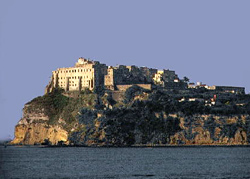 Modern-day
travelers in the Bay of Naples can sail by and miss the Isle of Procida
as easily as the Greeks did three-thousand years ago. Even from the
vantage point across the bay on the Sorrentine coast or the heights
of Capri, the isle of Procida rides so low in the water that in bad
weather it is hard to spot. At best it looks like a smudged extension
of the mainland. Approaching it dead on from the south, you may not
even recognize it as separate from the neighboring island of Ischia. Modern-day
travelers in the Bay of Naples can sail by and miss the Isle of Procida
as easily as the Greeks did three-thousand years ago. Even from the
vantage point across the bay on the Sorrentine coast or the heights
of Capri, the isle of Procida rides so low in the water that in bad
weather it is hard to spot. At best it looks like a smudged extension
of the mainland. Approaching it dead on from the south, you may not
even recognize it as separate from the neighboring island of Ischia.
Procida
has an equally low figurative profile: compared to the other islands
in the bay, Ischia and Capri, the island is relatively unfrequented
by tourists. And certainly, after the flood of English and German that
accosts your ears on those other islands, you get the distinct and accurate
impression that on Procida, Italian is the native language.
Tourist
brochures about Procida usually read something like this:
| Of
the islands embracing the Gulf of Naples, Procida has best succeeded
in preserving its original, genuine beauty, unpolluted nature
and simplicity of life. This tiny isle, cradled in clear and shining
waters, is a precious jewel case inbosoming natural sceneries
of exquisite green shades, colors of bygone ages, iridescent views,
and a wealth of marvelous sights of a primitive and wild grandeur.
The natural harbors abound with fishing boats, reminders
of the ancient traditions cherished by the inhabitants… |
And so
on. Native Procidians are almost embarrassed by that kind of language.
After all, they pride themselves on not being a tourist Mecca. They
are mainly farmers and sailors. They work for a living and have many
of the same problems as working people anywhere else.
The most
prominent physical feature of the island is the medieval fortress, the
so-called “Terra murata,” set high above the sea on the
eastern approach to the main harbor. It has, over the years, gone
from being a fortress to a penitentiary to what it is today, a monument
open to the public. Besides the main harbor, there are two smaller harbors,
Coricella, set right below the imposing ex-fortress, and Chiaiolella,
a small natural harbor at the southern extreme of the island. Here is
where you can believe the tourist brochures—these two tiny harbors
are truly peaceful and picturesque.
Also worth
a visit is the neighboring islet of Vivara; flanking Procida to
the south-west and connected to it by a bridge, this crescent-shaped
remnant ridge of an ancient volcanic crater is now a nature preserve.
It is also the site of recent archaeology that has uncovered fragments
of Mycenaean pottery, left by Greeks who were there many centuries before
the "original" Greeks colonized the bay.
(Also see
this entry.)
Murolo,
Roberto; Neapolitan Song (3)
 The
large double–door entrance to via Cimarosa 25 in the Vomero section
of Naples was half–closed this morning, as is customary when someone
in the household passes away. And—as is customary—a small
white card was affixed to the door. It was written by hand and read,
succintly, "For the death of Roberto Murolo". He was 92. It was, perhaps,
the only non–violent thing that could have happened in Naples
yesterday to push today's visit to the city by the ex–royal family
of Italy, the Savoys, out of the headlines. And it did. The
large double–door entrance to via Cimarosa 25 in the Vomero section
of Naples was half–closed this morning, as is customary when someone
in the household passes away. And—as is customary—a small
white card was affixed to the door. It was written by hand and read,
succintly, "For the death of Roberto Murolo". He was 92. It was, perhaps,
the only non–violent thing that could have happened in Naples
yesterday to push today's visit to the city by the ex–royal family
of Italy, the Savoys, out of the headlines. And it did.
There are
three main reasons why one–thousand miles of Italians—from
the Alps to Sicily—know something about the culture and language
of Naples. The first reason is the great playwright Eduardo
de Filippo, on many a literary critic's "short list" of Those Who
Should Have Got a Nobel Prize But Didn't." The second reason—on
a more popular (and more vital) level—is Italy's greatest film
comic, Antonio de Curtis, known simply as "Totò".
The third reason is Roberto Murolo, the gentle and erudite chronicler
of Neapolitan music and the best–known singer in the twentieth
century of the "Neapolitan Song"
If Murolo
had simply been content to remain a guitarist and singer, he certainly
would have done very well, but he was born to more than that. His father
was the highly–regarded dialect poet Ernesto Murolo, part of the
long tradition of dialect literature that included his own contemporary,
Salvatore di Giacomo, and reached back
through the 18th–century libretti of the Neapolitan Comic Opera
to the 16th–century Pentamarone by Giambattista Basile, and beyond. Thus, Roberto Murolo
was very aware of being part of that tradtion, and his great contribution
to the music of Naples is a scholarly one. He dedicated years of his
life to researching, collecting and documenting Neapolitan music and
in 1963 published what amounted to a musical encyclopedia of the music
of Naples, a 12 LP set containing songs from 1200 to 1962, all carefully
documented and explained and all immaculately sung by Murolo, himself.
He sang in the precise pronunciation of a literary language, quite different
from the uneducated "street sound" that one often associates with the
term "dialect".
Murolo
is not the reason that Neaplitan songs such as 'o sole mio
and Funiculì–Funilulà are known abroad. That
goes back to yet an earlier generation, the years at the turn of the
century when so many Neapolitans emigrated and took their music with
them. Interestingly, however, Murolo was part of the post–WW2
generation of Neapolitan singers who resisted the onslaught of American
popular music and helped keep the traditional music of his native culture
from becoming passé.
Although
he became less active with advanced age, Murolo never really retired.
He took part in the 1993 version of the annual Festival of Italian Popular
Music in San Remo with a song entitled "L'Italia è bella,"
a song against racism and xenophobia. And while "cross cultural" music
is run of the mill today, Murolo was doing that as long ago as 1974,
when he sought out and sang with the great Portughese performer of Fado,
Amalia Rodriguez. Murolo was an inspiration to the "friendly rivals"
of his own generation such as Sergio Bruni and to the younger generation
of singers such as Massimo Ranieri and Pino Daniele, both of whom published
tributes to Murolo in the paper this morning. As with the passing of
Eduardo de Filippo in 1984 and Totò in 1967, there is a very
real sense of loss in Naples today.
|
